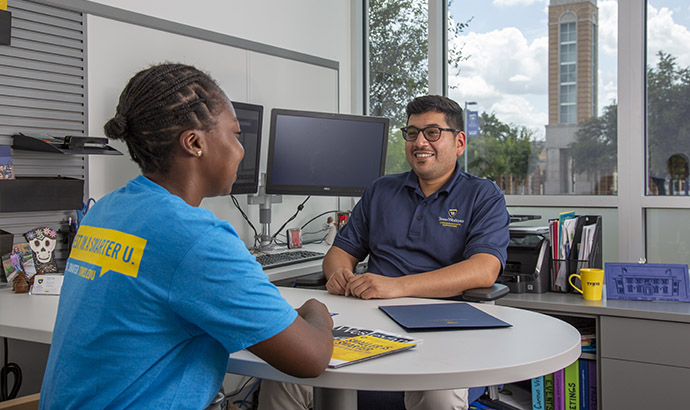Syllabus - A Golden Opportunity
.jpg)
“When students read your syllabus, they are not just wondering, “Which textbook should I buy?” and “When is the midterm?” They are also wondering, “Can I succeed in this course?” and “Do I belong in this field?” The messages students receive early on can shape their perceived answers to these questions, and impact the way they experience your course throughout the term. They can even influence whether students disengage and drop the course when it gets challenging, or stay motivated and persist to earn the credit..” (Your Syllabus as a Tool to Promote Student Equity, Belonging, and Growth, n.d.)
What is the syllabus?
A roadmap. A blueprint. A guidebook. There are all types of metaphors to describe a syllabus and its purpose in a college course. In essence, a syllabus is the overall guide to the course. It includes everything from policies to assignments and a course schedule. But it can be more than that. Consider the syllabus an opportunity. This is the first opportunity for the instructor and the student to have communication. It is an opportunity for the instructor to set the mood for the course. It is an opportunity to build relationships and to build confidence in a student. A well-written syllabus can prepare a student for success in any given course.
What is in the syllabus?
Like a trusted recipe, a syllabus has specific ingredients as well as ingredients to add a little something extra.
Welcome: This is your opportunity to set the tone for the course. Start with a cherry message, letting students know you are glad that they are part of this journey. Later, you will provide the course description, but this is an opportunity to explain why you are excited about the course, why you teach what you teach, and how the course will benefit them (even if it is not a required course for their major).
Course Description: By providing the word-for-word description from the course catalog, you are getting on the same page regarding the overall expectation of the course.
Learning Outcomes and Program Goals: Students need to know the destination. The learning outcomes provide guidance to what students will leave with. This gives students an idea of what they should be able to do by the end of this course. Here are some general guidelines for course learning outcomes (CLOs):
-
Most courses will have 3-5 CLOs
-
They start with a general statement addressing the student. (Ex/Students will be able to...)
-
They are written at a higher level of Blooms Taxonomy (analyzing, evaluating, creating) to challenge students.
-
They are direct and to the point with little “fluff.”
The overall course needs to connect to the goals of the program. Your dean or lead should have access to the overall program goals. The syllabus is the opportunity to connect each CLO to specific program goals. This allows the student to see the big picture and understand why they are taking the course. Ensure that students can access program goals (either have them written out or provide a link to the program goals) so students can see the connection.
Needed Materials: This includes a list of all academic materials that the student will need for the course. Included but not limited to:
-
Textbooks
-
Workbooks
-
Online resources and programs
For each textbook and workbook, include the author, title, edition, publisher, year, and ISBN to ensure that the student obtains the correct one. Include ways to access the materials and what the cost is (if any).
Student Workload Expectation: This is where you would clarify the modality of the course (face-to-face, hybrid, or fully online) as determined by the university. Address what students could expect related to the amount of class time, amount of time expected outside of class, and whether they can expect synchronous or asynchronous work. The university has requirements based on accreditation. If you are unaware of the requirements, reach out to your dean or contact the CETL.
Evaluation and Grading: Usually in the form of a table, this section breaks down the assignments and assessments, including the score connected with each one. This is also your opportunity to clarify what constitutes an A, a B, etc... Here, you can also include additional details about grading. This is not the place to provide instructions for a project, etc... It is recommended that you have specifics in the assignment to accomplish that.
Procedures specific to the course: These procedures are unique to the course and the instructor. Often, schools/departments may have similar procedures to ensure uniformity. They may include:
-
Assignment Submission (specify the LMS that is used)
-
Assignment feedback and instructor communication
-
Software/app/equipment needed
-
Instructional methods, learning methods, and technologies used.
Instructor Policies: Although these might be unique to the instructor, they are likely aligned with university policies. Such policies include:
-
Class Attendance
-
Academic Integrity
-
AI Policy
-
Late Assignment Policy
There are times when a policy of yours may be that you have no specific policy. Inform students of this so that they are not left guessing (ex/ If you do not accept late work, specify that as your “Late Assignment Policy”).
Schedule: Here is where you map out the semester, usually by weeks or by class meetings. This can include topics, assignment/assessment due dates, and holidays/special events.
Although there may be norms, the order of information in the syllabus varies. Most universities have templates to provide uniformity for the students.
At Texas Wesleyan University, we have a template with specific university-wide information. The template is set up with links that update as needed. Contact CETL for assistance in setting up your syllabus.
What is a “liquid syllabus?”
At Texas Wesleyan University, we utilize a liquid syllabus. Through the use of a liquid syllabus, students are provided with “an open, equitable, and humanizing introduction to the course” (Baule, 2024).
What makes the syllabus “liquid?” The characteristics of a liquid syllabus include the following:
-
Humanizing language that is welcoming to the student and minimizes student anxiety.
-
Easily accessible, often in the form of a webpage.
-
Can be accessible on multiple platforms and devices. Students can view it easily on a computer, tablet, or cell phone.
-
The ability to update with ease. If a course relies solely on a paper copy or a PDF, and a change has to be made mid-semester (ex/ if the schedule had an incorrect date), the instructor would have to find the file, make the edit, download it, and ensure that the students have access to the correct file. With a liquid syllabus, the instructor simply makes edits within the webpage or LMS and notifies the students.
-
A uniform template that can be easily copied to courses and course specific adjustments made through user friendly editing.
-
Interactive. Since the liquid syllabus is in webpage form, instructors can use video, audio, and graphics to make it more engaging.
(Baule, 2024)
How does the liquid syllabus work at Texas Wesleyan University? A liquid syllabus template is provided through Canvas Commons. This template includes university specific information in uniform language as well as links to university policies and resources. The syllabus is copied to the Canvas course and is accessible through the course menu. Instructors make course specific changes (ex/required textbooks, grading, schedules), and make it unique to themselves and the course. Instructors have the ability to make edits that are updated in real time. The syllabus moves with the course meaning that when the course is copied for the next semester, the syllabus remains within the course.
You can set up your liquid syllabus in your Canvas course by visiting the tutorial in the CETL Hub. Liquid Syllabus.
If you need assistance in setting up the liquid syllabus for your Texas Wesleyan University course, contact CETL to schedule an appointment.
How can I make my syllabus more “human?”
As stated earlier, the syllabus is an opportunity. An opportunity to set the stage, make a first impression, and to build a relationship, all before a student meets you for the first time. Traditionally, students can find a syllabus confusing, hard to read, and, thus, a waste of time. What can you do to make the overall syllabus more “human,” easier to understand, and an effective tool for students?
-
Incorporate a welcome video. This allows students to “see” you and experience your personality. Additional videos can be added throughout the syllabus.
-
Use language that is uniform with other courses, both within the program and within the university. As instructors and content experts, we would rather students spend time on the content and not on trying to figure out how to interpret each courses’ syllabus.
-
Provide access to student support services, including tutoring, accessibility support, and other university programs. This access could be through links in the syllabus or at the beginning of the course in the LMS. This lets the students know that you care for their success not only in your course but as a college student.
-
Make it easy to have their questions answered. This could be through access to the instructor, ability to set up appointments with the instructor, FAQ sections, links to other resources, and links to a Q & A forum.
-
Make it easy to contact you. Include your office location, phone, and email address, as well as office hours. Consider adding an easy way to set an appointment with you, including a link to a scheduler (such as Microsoft Bookings) or a standing Microsoft Teams meeting that students can join.
-
Ensure that the syllabus is ready as soon as the course is available (prior to the start of class). Since the liquid syllabus is attached to the LMS, when the university makes courses available, the syllabus is available. Having early access gives students the ability to review the course and plan accordingly, thus minimizing anxiety.
-
Include what students can expect from you. Some might call this a “pact” or a “social contract.” The syllabus will outline what students have to do but do you include what your responsibilities as the instructor are? This allows the students to see that you are a part of their success.
-
Consider your language. Is it helpful and supportive or authoritative and punitive? Read your syllabus out loud and see how it sounds.
-
Check for grammar, professionalism, and organization. If a syllabus is hard to read and hard to understand, it creates a roadblock and obstacle to student learning. Consider having a colleague review it and consider adding a review of the syllabus to your course evaluation.
-
Add a “What To Expect The First Week Of School” section. This could ease anxiety and provide an understanding of what to expect.
-
Create a “Tips For Success” section that outlines how to be successful not only in this course, but in college overall.
Consider mindset: The syllabus is the first opportunity that you establish the mindset of course. An instructor can set the mindset of the course through their wording and guidelines established in the course syllabus. A course with a fixed mindset implies to students that you either have it or you don’t, and that if they are not successful, it’s because they can’t accomplish the skills needed. This can make the students feel that the instructor does not believe in them and their ability, and that they do not belong in the course. On the other hand, a growth mindset informs students that if they apply themselves, they can grow, learn, and be successful, no matter the content. A growth mindset states that it is ok to be challenged by the content and getting help and assistance is expected. This creates a sense of belief and accomplishment, and it communicates to the student that they belong. (Your Syllabus as a Tool to Promote Student Equity, Belonging, and Growth, n.d.)
What is the mindset of your course?
Conclusion
Consider your syllabus an opportunity for so much more than just a “to do list.” Let it be an opportunity to let your students know that you care for their success. Let it be an opportunity to create a relationship and to let them know that you will support them.
Need More?
As you move onto your next steps, contact CETL to set an appointment. CETL can help you set up your liquid syllabus, brainstorm how to “humanize” your syllabus, and can review your current syllabus.
Do you want to dig deeper into how you can use your syllabus to set the tone of your course. Consider completing this free online module. It will help you understand the importance of using your syllabus to create a sense of belonging and provides tools for you to evaluate your own syllabus. It will take a couple of hours and did I mention it is free.
Your Syllabus as a Tool to Promote Student Equity, Belonging, and Growth
References
Baule, S. M., EdD PhD. (2024, January 26). Key elements for building a liquid syllabus. eCampus News. https://www.ecampusnews.com/teaching-learning/2024/01/26/key-elements-for-building-a-liquid-syllabus/
ProfKelley. (2021, August 10). Building a liquid syllabus using Google sites [Video]. YouTube. https://www.youtube.com/watch?v=azzlUIksRNM
Your Syllabus as a Tool to Promote Student Equity, Belonging, and Growth. (n.d.). SEP Training Library. Retrieved June 23, 2025, from https://library.studentexperienceproject.org/courses/take/syllabus/texts/17404762-about-this-module







